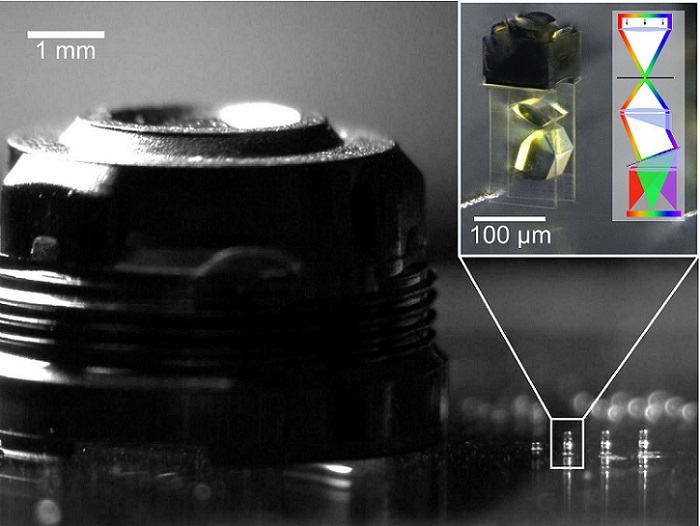Researchers from the University of Stuttgart have developed a microscale spectrometer that can be fabricated through femtosecond direct laser writing. The angle-insensitive 3D-printed miniature spectrometer has a direct separated spatial-spectral response, and a volume of less than 100 × 100 × 300 μm3.
According to the researchers’ paper, the team could fabricate the spectrometer directly on a miniature image sensor as the tip of a distal chip endoscope, which would allow examination of previously inaccessible regions of the body with extremely high bending radii. Additionally, the technology may find applications in hyperspectral imaging where it could be used as a unit cell, or macro pixel. There, the redistribution of spectral energy rather than high-loss Fabry-Pérot filtering could enable highly efficient hyperspectral imaging sensors.

The inset (white box) shows a microscope image of the fabricated spectrometer (left) and its optical design principle (right). Courtesy of Toulouse et al.
Femtosecond direct laser writing as a 3D-printing technology has been a key driver of miniaturization, having transformed the field of complex micro-optics in the early 2000s. Medical engineering and consumer electronics have benefitted greatly from the technology.
Conversely, the miniaturization of spectroscopic measurement devices has been advanced by technologies such as quantum dots and nanowire technology. Those are based on computational approaches, which have certain drawbacks, such as being calibration sensitive and requiring complex algorithms for reconstruction.
The design presented by professor Alois Herkommer from the Institute of Applied Optics and professor Harald Giessen from the 4th Physics Institute at the University of Stuttgart is based on a classical grating spectrometer and was fabricated through two-photon direct laser writing, combined with superfine inkjet process. The tailored and chirped high-frequency grating delivered strongly dispersive behavior. The spectrometer operates in the visible range of the spectrum from 490 to 690 nm, and has a spectral resolution of 9.2 ± 1.1 nm at 532 nm and 17.8 ± 1.7 nm at a wavelength of 633 nm.
“With its volume of less than 100 × 100 × 300 μm3, we explore a whole new size range for direct spectrometers,” said Andrea Toulouse, lead author on the paper describing the new device. “An order of magnitude this small could only be realized by computational approaches until now. In contrast, we translate the spectrum directly into a spatially encoded intensity signal that can be read out with a commercial monochromatic image sensor.”
For 3D-printed micro-optics, Toulouse said, the complex optical design is a milestone.
“Refractive, diffractive, and spatially filtering elements have never been combined in such a small volume to create a complex and monolithic measurement system,” she said.
The research was published in Light: Advanced Manufacturing (www.doi.org/10.37188/lam.2021.002).